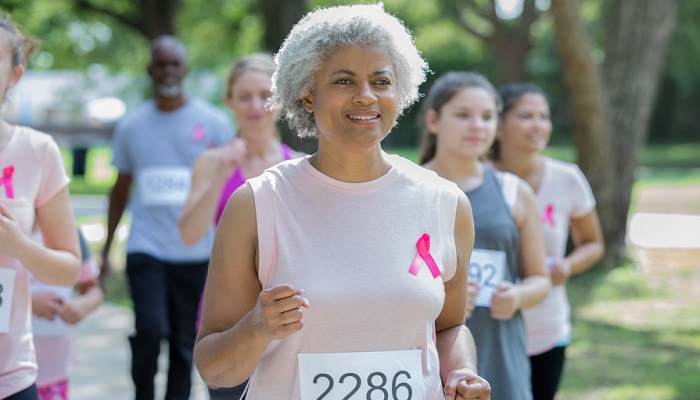
By Robert L. Herron, MA, CSCS*D, ACSM-CEP |
October is National Breast Cancer Awareness Month in the United States and, according to the National Breast Cancer Foundation, 1-in-8 women in the US will develop breast cancer in their lifetime. Breast cancer is the most common for cancer for women in the United States – independent of race or ethnicity (excluding skin cancer).
All women are encouraged to undertake positive lifestyle habits to lower the risk of developing breast cancer as well as practice and discuss early-detection protocols with their medical provider. Fortunately, due to increased awareness, self-checks, and improvements in the medical field, breast cancer diagnosis and mortality rates have started to level-off or decline this decade.
However, the fight is far from over. While there is a need to continue to improve preventative services and treatments, there is also a need to improve how society can help survivors. Breast cancer survivors face a sequalae of issues, related to their treatment, that negatively impact one’s health and quality of life. This article will highlight the need to improve exercise and physical activity programs for breast cancer survivors, adding years to their life, and life to their years.
It is estimated there are more than 3.5 million breast cancer survivors. Approximately 90% of breast cancer patients survive at least 5 years after their initial diagnosis. However, one issue that receives less attention is the toll that breast-cancer’s pharmacological and radiological treatments have on cardiovascular health, particularly in survivors. In 2018, the American Heart Association released a much-needed scientific statement regarding the issue because these two, health-related issues intersect.
Heart disease is still the leading cause of mortality in women. In breast cancer survivors, the problem is worse. In older, postmenopausal women, those that survived breast cancer have a higher mortality rate – attributable to cardiovascular disease – than that of their peers with no history of breast cancer. To date, evidence shows that cardiovascular-disease risk becomes most clear starting 7 years after breast-cancer diagnosis. Additionally, in subgroups of older women with early-stage breast cancer, non-breast cancer deaths rates exceed those attributable to breast cancer.
It is well known that chemotherapy and radiation therapy are hard on the body. These treatments have several deleterious effects on cancer cells and healthy cells, through myriad of known and unknown mechanisms. A common term used in this space to describe the side effects is, cardiotoxic. Simply put, therapeutic agents attempt to prevent cancer cells from replicating and/or growing, but all drugs have side effects, and these are particularly harsh on the cardiovascular system.
As such, standard breast-cancer treatment is associated with short-term and long-term cardiotoxic side effects leading to the subsequent decline in one’s functional capacity to be physically active, the development of chronic fatigue, and the progression of many other comorbidities related to quality of life. To that end, it is important to increase awareness regarding the need to support breast cancer survivors, after their cancer treatment ends, and support them to live a long, healthy life.
Expanded grant opportunities are warranted and access for Survivorship Programs should expand to increase the reach and impact of such programs. Scientists, practitioners, and patients need support in developing screening programs, exploring best practices for exercise prescription and progression is extremely important, and evaluating how to create comprehensive and inclusive public-health messaging in this area.
From a physical activity perspective, we know exercise and physical activity are good. As long has the physician clears the patient for exercise, goals should be to increase movement, progressively increase functional capacity, and improve all aspects of physical fitness. In this application, some activity is better than none, and more is better than less. The physical activity recommendations for survivors is the same for all adults; survivors are encouraged to engage in at least 150 minutes/week of moderate-intensity or 75 minutes/week of strenuous-intensity aerobic exercise and total-body strength training exercises twice weekly. However, as with all physical activity interventions, all stakeholders must come together and create awareness about the need for programming that specifically addresses the barriers, major concerns, and comorbidities related to breast-cancer survivorship.
As a whole, the intersection between exercise and breast cancer survivorship is an area that warrants more attention from the medical community, patients, practitioners, and society writ large. This October, please make sure to also bring awareness to the ways survivors of breast cancer can include exercise and physical activity programming to improve their health and quality of life.
Survivorship does not end at remission.
Robert L. Herron is a faculty member at the United States Sports Academy. Robert is a Certified Strength and Conditioning Specialist® with distinction from the National Strength and Conditioning Association (NSCA-CSCS*D®) and a Clinical Exercise Physiologist through the American College of Sports Medicine (ACSM-CEP®). rherron@ussa.edu